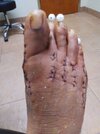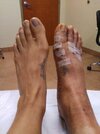Here a little update on my foot situation. Since the first time I posted in this thread, I have done everything I could think of to eliminate the bump between the 2nd and 3rd toe; all types of exercises to strengthen the muscles in the foot (which did work, thanks again @France and @gottathink with your great Foot Collective), rest, got insoles as per the ortho’s specs, barefoot shoes, toe spreaders, massages, arnica, you name it. The sensitivity between these toes first manifested on May 21st. We are now well over 3 months later and nothing I’ve been doing has worked. Sometimes the bump got a bit smaller but the sensitivity remained, especially when walking for about 20 minutes. So, conclusion, what I’ve been doing apparently doesn’t work.
Last night I went to see another ortho for a second opinion. This is an elderly man with tons of experience and a twinkle in his eye, pleasant guy. He studied the X-ray and examined my feet. He didn’t mention the hallux valgus at all, commented that my feet are fine, but he said that the X-ray showed that the width of the second toe base bone was about 60% larger than the other ones and there is this piece of something between the 2nd and 3rd toe base bones that he wants to investigate, it may be bone or something else. So he recommended I have an MRI to get more information. He mentioned that one of the options that crossed his mind was that a chunk of the base bone of the 2nd toe is surgically removed, a small pin put in, let it heal, he said 4 to 6 weeks, then remove the pin and all would be well. Interesting that according to him this issue is not caused by hallux valgus or the position of the 2nd toe, he also said that he doesn’t know if it is indeed bone touching that causes the bump, and he said insoles, special shoes and all that stuff won’t make a bit of difference. The previous ortho had not remarked on the bone size at all.
So, I just came back from the MRI, and I have an appointment with him to discuss the results next week Monday, should they have come in by then.
I had a terrible time getting to sleep last night (in spite of reading 2 chapters of Stella Riley’s Brandon Brothers part 3 which I just love), and at one point managed to allow the fear that I was feeling to just course through my body without any comment or judgment, which worked, and I slept till 5.45, which is good. You see, when I was 29, I had “simple” meniscus surgery which went awry (doc had also said I’d be up and about in 1 to 2 weeks), my knee blew up to the size of a football, had surgery again, which was fruitless and spent 3 months in bed, more or less sedated because of the immense pain (and I think I have a pretty high pain tolerance), before I was able to slowly start walking again. My knee has never been the same and has been flaring up every now and again, but it’s good enough for me, as I could walk and play 18 holes of golf without any problems. Perhaps it was an infection? That would explain the myriad of drugs and antibiotics I was put on.
Needless to say, I would not much like a repeat of that situation, so I’m feeling quite wary with respect to any surgery. On the other hand, it’s not an option to go on like this; I’m a very energetic and active person and love to go out and about in nature! Well, I just have to wait and see what the MRI results bring and what the doc says, keeping in mind that a man suffers most by the suffering he fears, but which never appears (old Dutch expression), and that we don’t know what’s coming in the health care sector in the EU and if he indeed highly recommends surgery, not to wait too long. I will post again when I have further news, perhaps then it will be time to network about surgery options as per Joe's suggestion above. In the meantime i accept it as it is and make the best of it! If anyone has any suggestions or comments, I'd love to hear it, thanks in advance.
Last night I went to see another ortho for a second opinion. This is an elderly man with tons of experience and a twinkle in his eye, pleasant guy. He studied the X-ray and examined my feet. He didn’t mention the hallux valgus at all, commented that my feet are fine, but he said that the X-ray showed that the width of the second toe base bone was about 60% larger than the other ones and there is this piece of something between the 2nd and 3rd toe base bones that he wants to investigate, it may be bone or something else. So he recommended I have an MRI to get more information. He mentioned that one of the options that crossed his mind was that a chunk of the base bone of the 2nd toe is surgically removed, a small pin put in, let it heal, he said 4 to 6 weeks, then remove the pin and all would be well. Interesting that according to him this issue is not caused by hallux valgus or the position of the 2nd toe, he also said that he doesn’t know if it is indeed bone touching that causes the bump, and he said insoles, special shoes and all that stuff won’t make a bit of difference. The previous ortho had not remarked on the bone size at all.
So, I just came back from the MRI, and I have an appointment with him to discuss the results next week Monday, should they have come in by then.
I had a terrible time getting to sleep last night (in spite of reading 2 chapters of Stella Riley’s Brandon Brothers part 3 which I just love), and at one point managed to allow the fear that I was feeling to just course through my body without any comment or judgment, which worked, and I slept till 5.45, which is good. You see, when I was 29, I had “simple” meniscus surgery which went awry (doc had also said I’d be up and about in 1 to 2 weeks), my knee blew up to the size of a football, had surgery again, which was fruitless and spent 3 months in bed, more or less sedated because of the immense pain (and I think I have a pretty high pain tolerance), before I was able to slowly start walking again. My knee has never been the same and has been flaring up every now and again, but it’s good enough for me, as I could walk and play 18 holes of golf without any problems. Perhaps it was an infection? That would explain the myriad of drugs and antibiotics I was put on.
Needless to say, I would not much like a repeat of that situation, so I’m feeling quite wary with respect to any surgery. On the other hand, it’s not an option to go on like this; I’m a very energetic and active person and love to go out and about in nature! Well, I just have to wait and see what the MRI results bring and what the doc says, keeping in mind that a man suffers most by the suffering he fears, but which never appears (old Dutch expression), and that we don’t know what’s coming in the health care sector in the EU and if he indeed highly recommends surgery, not to wait too long. I will post again when I have further news, perhaps then it will be time to network about surgery options as per Joe's suggestion above. In the meantime i accept it as it is and make the best of it! If anyone has any suggestions or comments, I'd love to hear it, thanks in advance.




 .
.
